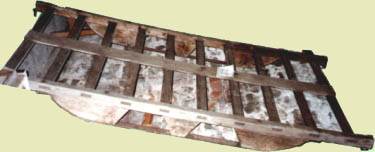The hay sled

The hay sled was a great Lakeland implement. Where flat ground is rare, it was essential to have a method of transporting hay or bracken that would not tip over sideways on steep slopes.
A cart has too high a centre of gravity, but a sled can be loaded higher than a cart and is always stable. And it can be hitched backwards or forwards - it doesn't have to be turned round! The sled at Dalemain is about 6 feet wide by 9 feet long.
Children and women often helped to lead a horse home with one loaded sled while the men gathered up and loaded the next. Cumbrian farm workers still talk of "leading" hay when they are moving it from field to barn. Hay sleds were also used to bring home bracken for bedding when straw was not available. This also weakened the bracken, which is a strong-growing fern, and helped to increase the grazing area on the fell.
David Trotter:
"We used to go for brackens for bedding- you couldn’t bring ’em off in a cart with wheels, so you’d to sledge them. If it had weight, the horse had to pull it forward, even downhill - if the horse stopped, it stopped. Been on snow, it would’ve gone, run t’hoss over. No, same as you were out on’t fell, no; the horse had to pull it downhill even."
Edna Morland: "You loaded the outer corners first, then the sides, and filled in the middle. You could get much more on that way, stack it higher, maybe six feet high."
Joyce Postlethwaite: "When Ah was a lile lass, Ah used to be given t’ job of leading t’ horse back from t’ field when the sled was loaded. Big horse, a Clydesdale. One day a horse bee (warble fly) got amang t’ horse’s legs and it turned just like that and got away on me and went all the way back up the field wi’t hay fleein’ off."